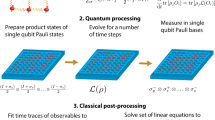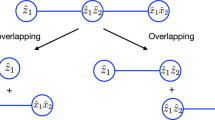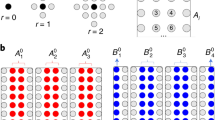Abstract
Predicting the properties of complex, large-scale quantum systems is essential for developing quantum technologies. We present an efficient method for constructing an approximate classical description of a quantum state using very few measurements of the state. This description, called a ‘classical shadow’, can be used to predict many different properties; order \({\mathrm{log}}\,(M)\) measurements suffice to accurately predict M different functions of the state with high success probability. The number of measurements is independent of the system size and saturates information-theoretic lower bounds. Moreover, target properties to predict can be selected after the measurements are completed. We support our theoretical findings with extensive numerical experiments. We apply classical shadows to predict quantum fidelities, entanglement entropies, two-point correlation functions, expectation values of local observables and the energy variance of many-body local Hamiltonians. The numerical results highlight the advantages of classical shadows relative to previously known methods.
This is a preview of subscription content, access via your institution
Access options
Access Nature and 54 other Nature Portfolio journals
Get Nature+, our best-value online-access subscription
$29.99 / 30 days
cancel any time
Subscribe to this journal
Receive 12 print issues and online access
$209.00 per year
only $17.42 per issue
Buy this article
- Purchase on Springer Link
- Instant access to full article PDF
Prices may be subject to local taxes which are calculated during checkout





Similar content being viewed by others
Data availability
Source data are available for this paper. All other data that support the plots within this paper and other findings of this study are available from the corresponding author upon reasonable request.
Code availability
Source code for an efficient implementation of the proposed procedure is available at https://github.com/momohuang/predicting-quantum-properties.
References
Preskill, J. Quantum computing in the NISQ era and beyond. Quantum 2, 79 (2018).
Cramer, M. et al. Efficient quantum state tomography. Nat. Commun. 1, 149 (2010).
Carrasquilla, J., Torlai, G., Melko, R. G. & Aolita, L. Reconstructing quantum states with generative models. Nat. Mach. Intell. 1, 155–161 (2019).
Torlai, G. et al. Neural-network quantum state tomography. Nat. Phys. 14, 447–450 (2018).
Aaronson, S. Shadow tomography of quantum states. In Proceedings of the 50th Annual ACM SIGACT Symposium on Theory of Computing (STOC 2018) 325–338 (ACM, 2018)
Aaronson, S. & Rothblum, G. N. Gentle measurement of quantum states and differential privacy. In Proceedings of the 51st Annual ACM SIGACT Symposium on Theory of Computing (STOC 2019) 322–333 (ACM, 2019).
Guta, M., Kahn, J., Kueng, R. J. & Tropp, J. A. Fast state tomography with optimal error bounds. J. Phys. A 53, 204001 (2020).
Gottesman, D. Stabilizer Codes and Quantum Error Correction PhD thesis, Caltech (1997).
Fano, R. M. Transmission of Information: A Statistical Theory of Communications (MIT Press, 1961).
Jerrum, M. R., Valiant, L. G. & Vazirani, V. V. Random generation of combinatorial structures from a uniform distribution. Theoret. Comput. Sci. 43, 169–188 (1986).
Nemirovsky, A. S. & Yudin, D. B. Problem Complexity and Method Efficiency in Optimization (Wiley-Interscience, 1983).
Greenberger, D. M., Horne, M. A. & Zeilinger, A. in Bell’s Theorem, Quantum Theory and Conceptions of the Universe. Fundamental Theories of Physics Vol. 37 (ed. Kafatos, M.) 69–72 (Springer, 1989).
Dennis, E., Kitaev, A., Landahl, A. & Preskill, J. Topological quantum memory.J. Math. Phys. 43, 4452–4505 (2002).
Flammia, S. T. & Liu, Y.-K. Direct fidelity estimation from few Pauli measurements. Phys. Rev. Lett. 106, 230501 (2011).
Gühne, O. & Tóth, G. Entanglement detection. Phys. Rep. 474, 1–75 (2009).
Weilenmann, M., Dive, B., Trillo, D., Aguilar, E. A. & Navascués, M. Entanglement detection beyond measuring fidelities. Phys. Rev. Lett. 124, 200502 (2020).
Kandala, A. et al. Hardware-efficient variational quantum eigensolver for small molecules and quantum magnets. Nature 549, 242–246 (2017).
Kokail, C. et al. Self-verifying variational quantum simulation of lattice models. Nature 569, 355–360 (2019).
Hoeffding, W. in Breakthroughs in Statistics 308–334 (Springer, 1992).
Brydges, T. et al. Probing Rényi entanglement entropy via randomized measurements. Science 364, 260–263 (2019).
Renes, J. M., Blume-Kohout, R., Scott, A. J. & Caves, C. M. Symmetric informationally complete quantum measurements. J. Math. Phys. 45, 2171–2180 (2004).
Nandkishore, R. & Huse, D. A. Many-body localization and thermalization in quantum statistical mechanics. Annu. Rev. Condens. Matter Phys. 6, 15–38 (2015).
Dasgupta, C. & Ma, S.-k Low-temperature properties of the random Heisenberg antiferromagnetic chain. Phys. Rev. B 22, 1305 (1980).
Ma, S.-k, Dasgupta, C. & Hu, C.-k Random antiferromagnetic chain. Phys. Rev. Lett. 43, 1434 (1979).
Bonet-Monroig, X., Babbush, R. & O’Brien, T. E. Nearly optimal measurement scheduling for partial tomography of quantum states. Preprint at https://arxiv.org/pdf/1908.05628.pdf (2019).
Raghavan, P. Probabilistic construction of deterministic algorithms: approximating packing integer programs.J. Comput. Syst. Sci. 37, 130–143 (1988).
Spencer, J. Ten lectures on the probabilistic method. In CBMS-NSF Regional Conference Series in Applied Mathematics 2nd edn, Vol. 64 (SIAM, 1994).
Carleo, G. & Troyer, M. Solving the quantum many-body problem with artificial neural networks. Science 355, 602–606 (2017).
Carrasquilla, J. & Melko, R. G. Machine learning phases of matter. Nat. Phys. 13, 431–434 (2017).
Paini, M. & Kalev, A. An approximate description of quantum states. Preprint at https://arxiv.org/pdf/1910.10543.pdf (2019).
Acknowledgements
We thank V. Albert, F. Brandão, M. Endres, I. Roth, J. Tropp, T. Vidick, M. Weilenmann and J. Wright for valuable input and inspiring discussions. L. Aolita and G. Carleo provided helpful advice regarding presentation. Our gratitude extends, in particular, to J. Iverson, who helped us in devising a numerical sampling strategy for toric code ground states. We also thank M. Paini and A. Kalev for informing us about their related work30, where they discussed succinct classical ‘snapshots’ of quantum states obtained from randomized local measurements. H.-Y.H. is supported by the Kortschak Scholars Program. R.K. acknowledges funding provided by the Office of Naval Research (award no. N00014-17-1-2146) and the Army Research Office (award no. W911NF121054). J.P. acknowledges funding from ARO-LPS, NSF and DOE. The Institute for Quantum Information and Matter is an NSF Physics Frontiers Center.
Author information
Authors and Affiliations
Contributions
H.-Y.H. and R.K. developed the theoretical aspects of this work. H.-Y.H. conducted the numerical experiments and wrote the open-source code. J.P. conceived the applications of classical shadows. H.-Y.H., R.K. and J.P. wrote the manuscript.
Corresponding author
Ethics declarations
Competing interests
The authors declare no competing interests.
Additional information
Peer review information Nature Physics thanks Yi-Kai Liu and other, anonymous, reviewer(s) for their contribution to the peer review of this work.
Publisher’s note Springer Nature remains neutral with regard to jurisdictional claims in published maps and institutional affiliations.
Supplementary information
Supplementary Information
Supplementary Figs. 1–4.
Rights and permissions
About this article
Cite this article
Huang, HY., Kueng, R. & Preskill, J. Predicting many properties of a quantum system from very few measurements. Nat. Phys. 16, 1050–1057 (2020). https://doi.org/10.1038/s41567-020-0932-7
Received:
Accepted:
Published:
Issue Date:
DOI: https://doi.org/10.1038/s41567-020-0932-7
This article is cited by
-
Cross-platform comparison of arbitrary quantum processes
npj Quantum Information (2024)
-
Error-mitigated fermionic classical shadows on noisy quantum devices
npj Quantum Information (2024)
-
Towards provably efficient quantum algorithms for large-scale machine-learning models
Nature Communications (2024)
-
Machine learning reveals features of spinon Fermi surface
Communications Physics (2024)
-
Understanding quantum machine learning also requires rethinking generalization
Nature Communications (2024)



